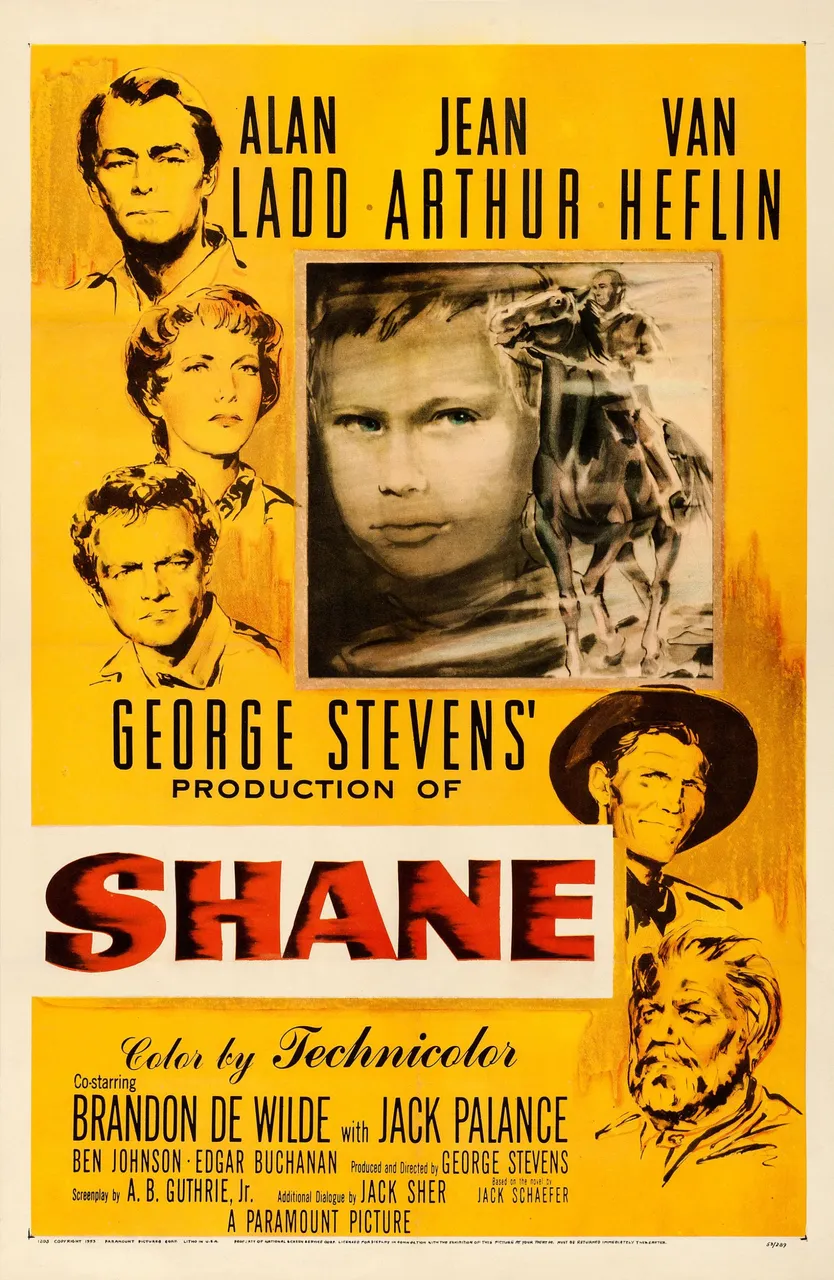
Shane is a 1953 American Technicolor Western film starring Alan Ladd, Jean Arthur, and Van Heflin. The film is directed by George Stevens and is based on Jack Schaefer's popular novel of the same name. The story revolves around a weary gunfighter, Shane (played by Alan Ladd), who rides into a small Wyoming town with hopes of quietly settling down as a farmhand. He befriends a homestead family, particularly the young son, Joey (played by Brandon deWilde), who idolizes him. The film is noted for its fine acting, intelligent and moving script and stunning cinematography.
Plot
Shane is a 1953 American Technicolor Western film directed by George Stevens and based on Jack Schaefer's novel of the same name. The story revolves around a weary gunfighter, Shane (played by Alan Ladd), who rides into a small Wyoming town with hopes of quietly settling down as a farmhand. He befriends a homestead family, particularly the young son, Joey (played by Brandon deWilde), who idolizes him.
Shane becomes embroiled in a conflict between cattleman Ryker and a bunch of settlers, like Joe Starrett and his family, whose land Ryker wants. When Shane beats up Ryker's men, Ryker hires a notorious gunfighter, Jack Wilson, to take care of Shane. In the final showdown, Shane kills Wilson, Ryker, and Ryker's brother, but is injured. Outside, Shane sees Joey, who notices that Shane is bleeding. In an iconic closing scene, Shane rides off into the sunset, leaving Joey and his family behind. The film explores themes of friendship, loyalty, and the struggle for a quieter life in the face of adversity. It is considered a classic of the Western genre and has been influential on subsequent Western films.
Trailer
Cast
- Alan Ladd as Shane
- Jean Arthur as Marian Starrett
- Van Heflin as Joe Starrett
- Brandon deWilde as Joey Starrett
- Jack Palance as Jack Wilson
- Ben Johnson as Chris Calloway
- Edgar Buchanan as Fred Lewis
- Emile Meyer as Rufus Ryker
- Elisha Cook Jr. as Torrey
- Douglas Spencer as Axel 'Swede' Shipstead
- John Dierkes as Morgan Ryker
- Ellen Corby as Mrs. Shipstead
- Paul McVey as Sam Grafton
- John Miller as Bartender
- Edith Evanson as Mrs. Howells
- Leonard Strong as Ernie Wright
- Ray Spiker as Ryker Man (uncredited)
- Gretchen W. Lee as Little Girl (uncredited)
- Martin Mason as Little Boy (uncredited)
- Nancy Kulp as Mrs. Lewis (uncredited)
- David McMahon as Clerk (uncredited)
- Helen Brown as Ruth Lewis (uncredited)
Director: George Stevens
Writer: A.B. Guthrie Jr. (screenplay), Jack Sher (additional dialogue), Jack Schaefer (based on the novel by)
Distributor: Paramount Pictures
Genre: Western
Release Date: 1953
Theme
The main theme of Shane is the struggle for a quieter life in the face of adversity, particularly in the context of the Old West. The film explores themes of friendship, loyalty, and the challenges of leaving behind a life of violence and danger.
Reception
Shane has been praised for its portrayal of the elegiac myths of the Old West and its unique juxtaposition of gritty realism. The film is considered a classic of the Western genre and has been influential on subsequent Western films.
Settings
The film is set in a small Wyoming town, where the homestead family and the cattleman Ryker's men clash over land rights. The movie showcases the rugged beauty of the Western landscape and the challenges faced by those trying to settle there.
Visual Styles
Shane features a combination of Technicolor cinematography and black-and-white photography, with the latter used for the more intense scenes, such as the final showdown. The film is known for its stunning visuals and the use of natural light to create a realistic atmosphere.
Techniques
The film employs a variety of cinematic techniques, including long takes, tracking shots, and high angles, to create a sense of authenticity and immersion in the story. The editing is smooth and unobtrusive, allowing the characters and their actions to drive the narrative.
Trivia
- The film's iconic closing scene, where Shane rides off into the sunset, was shot without any dialogue or music, allowing the audience to focus on the characters' emotions and the passing landscape.
- The film's production designer, John Meehan, was known for his ability to create realistic and detailed sets, which contributed to the overall visual appeal of the movie.
Fun Facts
- The film's director, George Stevens, was an experienced cinematographer who had previously shot and directed documentaries during World War II. His expertise in cinematography contributed to the film's visually striking nature.
- The film's lead actor, Alan Ladd, was a former child star who had not appeared in a leading role since the early 1940s. His performance as Shane helped to revitalize his career and solidify his status as a Hollywood icon.